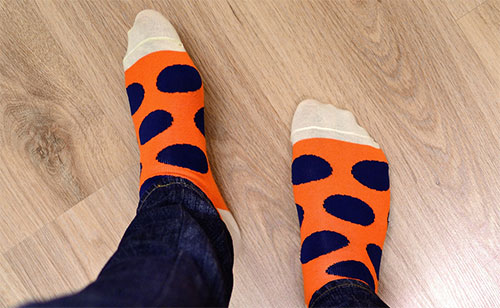Scientists Crack Lost Sock Code
This past Tuesday was National Lost Sock Memorial Day. If you weren’t aware of this solemn holiday, don’t worry. There’s still time to participate. Simply go to your sock drawer, remove all the lonely, mateless socks, have a moment of silence for them, then toss those socks. It’s time to let them go. You know you’re never finding their matches.
The Case of the Missing Sock is one almost anyone who has done a load of laundry has been asked to crack. Last year, scientists in the UK conducted research to determine why exactly socks get lost.

According to their report, in the just the UK alone, 84 million socks go missing each month! With a population five times that in the U.S., it stands to reason that Americans lose a pretty hefty load of socks too.
The Theory of Lost Socks
Many theories have been applied to the unsolved mystery of lost socks over the years.
1. They simply disappear somewhere within the depths of your washing machine or dryer. Slice your laundry appliances open, and perhaps all those AWOL socks will come tumbling out. Many a repair person will tell you that socks do sometimes get sucked into the drain hose.
2. Socks stowaway and make their escape. Static electricity fastens socks to jackets and sweaters. The wearer doesn’t notice, and at some point during the day the socks falls off onto the office floor or in the juice aisle at the grocery store.
3. Quantum mechanics is at work. This theory says that when there is a disturbance in the washing process, or when the appliance comes to a sudden stop, it causes a mathematical wave function of position and time. The socks never leave the washing and drying system, but they are sent to another point in time, different part of the system, or both. They may even be turned entirely into lint. Indeed, our socks are time travelers like Dr. Who.
4. Black holes. Renowned theoretical physicist Steven Hawking has even tried to solve this problem. He once proposed that missing socks get sucked into tiny black holes.
Lost Sock Research
The scientists who conducted the UK study say there is a better explanation. According to them, there are two main factors that determine if socks go missing.
- How complex the laundry is. Meaning how the loads are divided up by color and temperature.
- The number of socks in each load.
They also said there are four basic ways socks go missing.
- Socks slip behind or under an object where they are out of sight.
- Socks get separated from their mates and put into different loads of laundry.
- Socks hung up to dry outside get loose from clothespins and the wind blows them away.
- Socks are carelessly rolled up in mismatched pairs when laundry is put away.
The report proposes that a mathematical equation can be used to determine how likely it is that socks will be lost.
The Sock Loss Index = (L+C) – (PxA)
That’s Laundry Size, added to Complexity, minus Positivity, multiplied by Attention. Positivity being how much a person likes doing laundry, and Attention being how focused they are on the chore.
Once a sock goes missing, psychological factors come into play. We may search for the sock in logical places like the laundry bin or bedroom floor. If we don’t find it where we think it should be, we convince ourselves it’s disappeared. In reality, it’s just in an illogical place, like under the refrigerator. But we don’t care enough about the sock to keep looking. It’s easier to believe it’s gone forever.
Perhaps the valuable information in this new lost sock study is the first step to ending the tragedy of orphaned socks. Knowledge is power.



